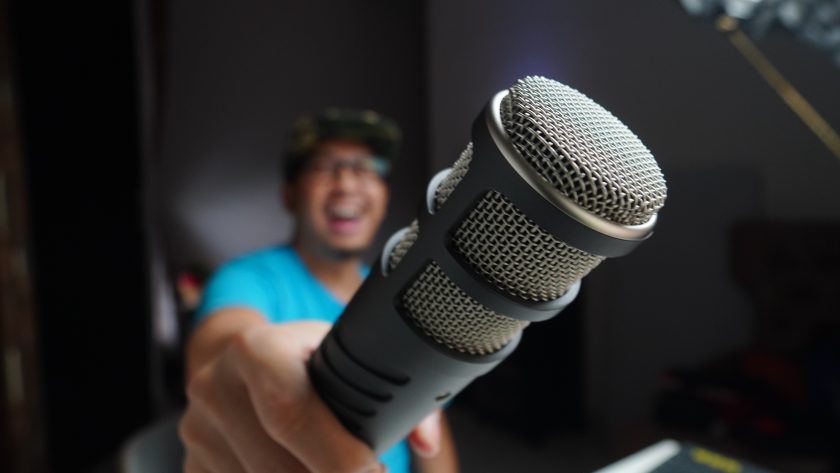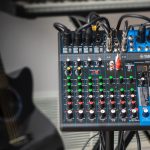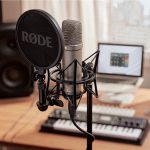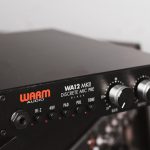In this review we feature the best dynamic microphones for recording vocals in your home recording studio or in a professional setting. These microphones are some of the best dynamic mics in the industry and have been around for a long time – they are capable of capturing your voice with good clarity and can reject off-axis surround sound with their cardioid polar pattern, allowing your vocals to come across as smoother with less background noise. While dynamic mics do not have the same level of clarity and detail as a condenser, they are great for recording at home because they capture less environmental detail and ambient noise.
If you aren’t sure what to get for your first home recording studio setup, I highly recommend the Shure SM58 or Sennheiser E 945 dynamic mics. These microphones have been around for a long time, and are considered the industry standard in studio recording.
1. Shure SM58-LC Dynamic Microphone
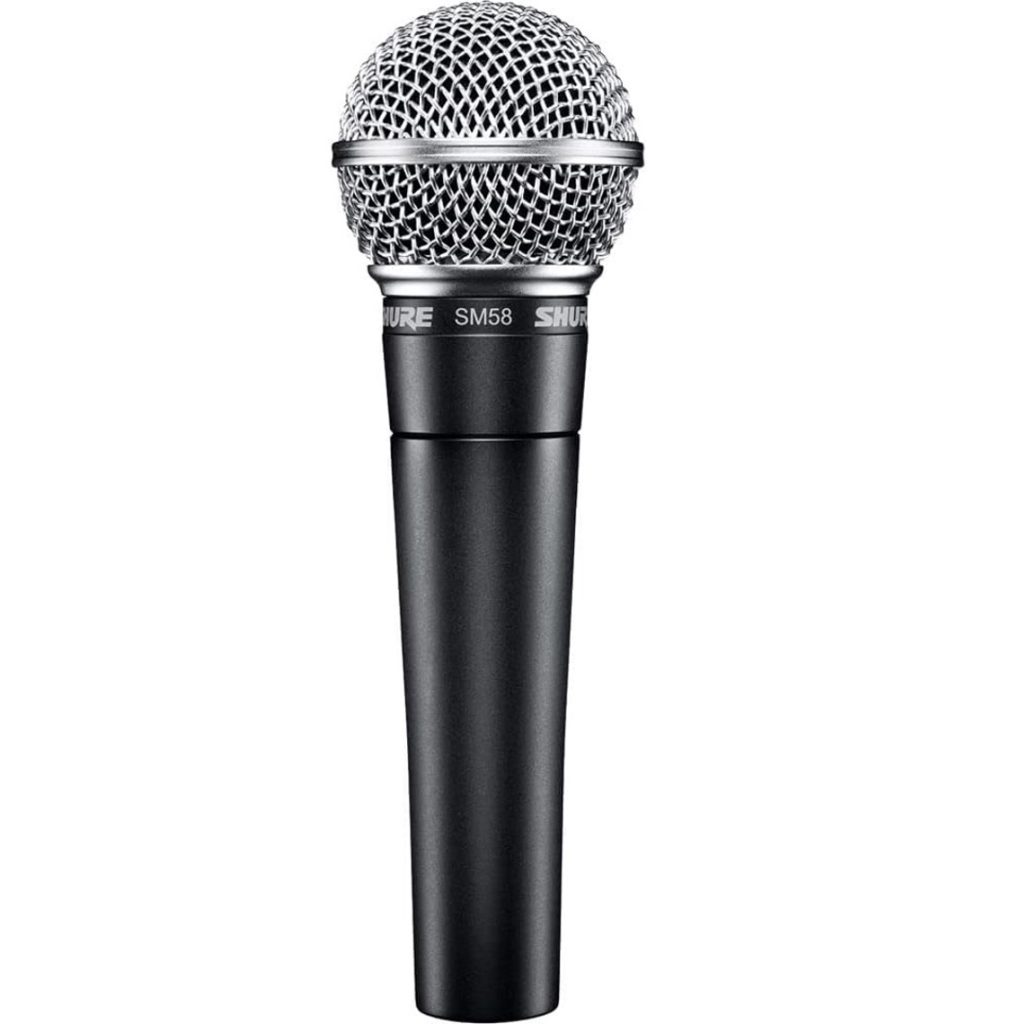
Long considered an industry staple…
The Shure SM58-LC is one of the best cardioid dynamic microphones you can find and is tailored for vocal clarity with a frequency response of 50Hz to 15kHz. This microphone reduces the proximity effect with a bass attenuation between 40-100Hz, which is ideal when recording vocals in a home studio setting, as it does not pick up much ambient background noise.
The SM58-LC has brightened midrange and a signature presence peak from 2kHz to 6kHz. The one thing I like about this mic is that it NEVER distorts, and you can literally scream into the mic and still get a clear recording on your DAW. The microphone has reasonable clarity, and the good thing is that it picks up your voice without recording ambient background sounds in your home studio.
This microphone is built with a rugged construction and comes with a break-resistant stand adapter and internal shock mount which cuts down handling noise. The spherical mesh grille and built-in pop filter are effective in minimizing wind and breath “pop” noise, which are ideal for home studios. These features also reduce the need for additional pop filters, simplifying your recording setup.
I really like the fact that the SM58-LC is a versatile microphone which is capable of recording both vocals and acoustic instruments effectively. The microphone comes with an XLR output connector, a storage pouch, and a mic clip, simplifying the setup process in your home studio.
This microphone is the industry-standard for audio recordings and we highly recommend them.
2. Sennheiser Professional E 945 Dynamic Microphone
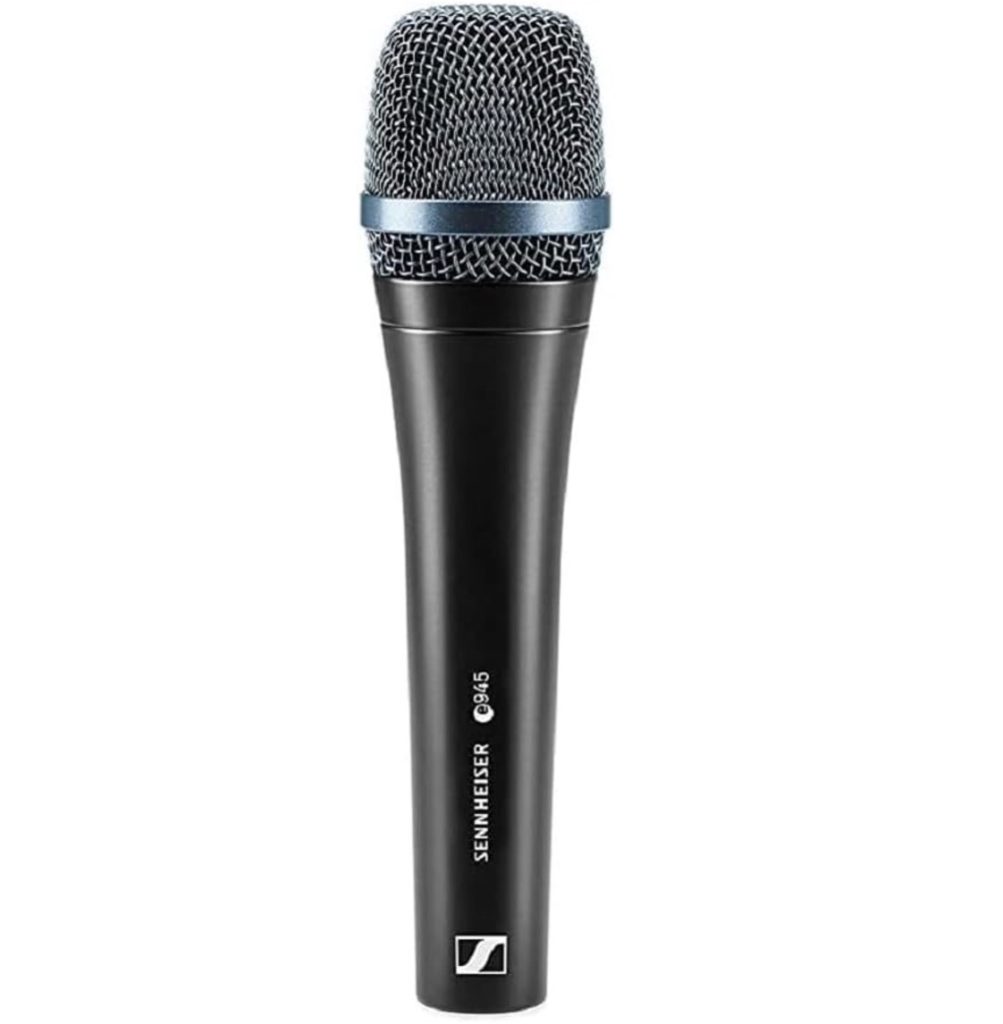
Similar to the Shure SM58 mic but has a broader frequency range…
The Sennheiser Professional E 945 Dynamic Super-Cardioid Vocal Microphone is a really good dynamic microphone with a wide frequency pickup range from 40 Hz to 18 kHz. This mic has a supercardioid pickup pattern which isolates the main sound source from other on-stage signals. If you are looking for a mic with the sound quality of the Shure SM58 BUT has wider frequency range capture (deeper bass), the Sennheiser E 945 is the go to mic.
I really like the sound performance of the Sennheiser E 945 microphone. This mic delivers really clean sound with crystal clear highs, and is capable of capturing deep bass frequencies. It also has a pretty good midrange capture and is suitable for recording acoustic guitar and drums where you get a good mix of highs and lows combined in the recording.
Compared to other dynamic microphones like the Shure SM58, the Sennheiser E 945 stands out for its superior off-axis noise rejection and feedback suppression due to its supercardioid pickup pattern. This pattern is tighter compared to the cardioid pattern of the SM58 and provides better sound isolation. This means that the E 945 has more clarity and detail than mainstream models like the Shure SM58.
We recommend the Sennheiser E 945 dynamic microphone for home recording studios due to its noise isolation capabilities and clear sound reproduction. The supercardioid pickup pattern is good for isolating vocals or instruments from unwanted ambient noise, and this mic has a wider frequency range than the Shure SM58.
Overall, the Sennheiser E 945 is a good investment and sounds slightly better than the Shure SM58 on a side by side comparison.
3. Shure SM48 Cardioid Dynamic Vocal Microphone

If you want a mic similar to the Shure SM58 on a low budget…
The Shure SM48 Cardioid Dynamic Vocal Microphone is the go to mic that we recommend if you are recording on a tight budget. It has a similar sound signature to the Shure SM58 mics but does not sound as “bright” – they are ideal for recording bass and drums. The microphone has a cardioid polar pattern which provides pretty good sound isolation and feedback rejection and delivers clear and natural sound reproduction.
The microphone’s neodymium magnet and fine-tuned frequency response provide a high signal-to-noise ratio, making it an ideal choice for recording drums or other loud instruments. The SM48’s tailored frequency response features a bass rolloff and midrange boost, providing clear and natural-sounding vocals.
Compared to the Shure SM58, the SM48 is the more affordable option but is somewhat “duller” than the SM58s in terms of sound signature. The SM58 has an overall brighter, clearer, and fuller sound, with a more present mid-range as compared with the SM48, and is an all-rounder (it can record vocals or drums). I would get the Shure SM48 purely for recording drums as it might miss out on some nuances and subtleties in your voice recordings.
The SM48 also requires slightly more gain to reach the same sound level as the SM58, making it a better choice for backing vocals (not lead vocals). It’s a great option to have if you are recording with multiple vocalists in the same room.
Overall, the Shure SM48 Cardioid Dynamic Vocal Microphone comes highly recommended for its decent sound signature and good off-axis rejection which reduces unwanted background noise and feedback.
4. Shure SM7B Dynamic Vocal Microphone
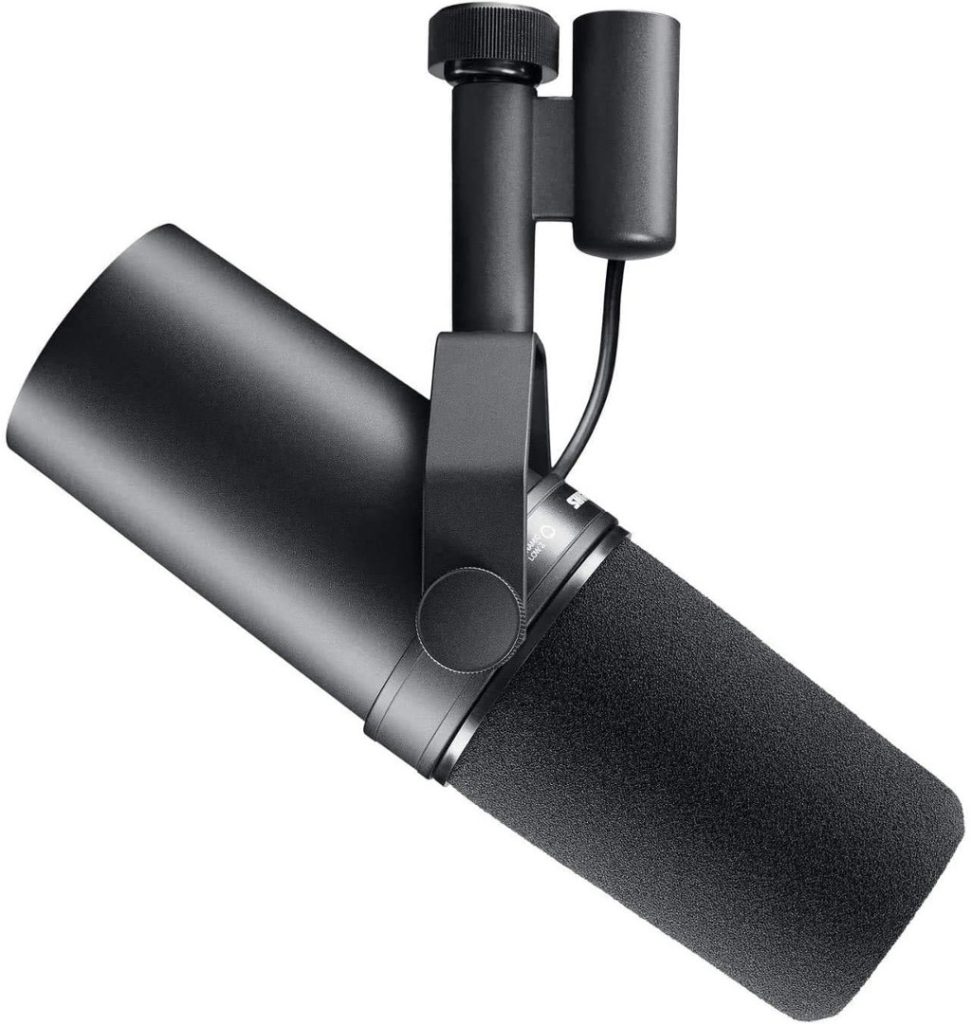
A well-regarded microphone for podcasting…
The SM7B is a workhorse microphone that has a formidable reputation in podcasting and in the recording studio industry. The SM7B has a smooth, flat, wide-range frequency response which makes it deal to capture your voice, and sounds great for both female and male vocals. The microphone features excellent shielding against electromagnetic hum generated by computer monitors and delivers a clean signal flow.
I really like the sound performance of the Shure SM7B. It has a pretty flat and neutral sounding frequency range and vocals are always recorded nicely with smooth textures – this microphone does not add any coloration to your vocals. The mic can capture female and male vocals really well and you get crystal clear sound without any distortion at higher volume levels. It’s better than the Shure SM58 as it is designed primarily for singing and podcasting, and captures more details than just a conventional dynamic mic would.
Compared to other microphones, the SM7B is an improvement over the previous Shure SM5 dynamic microphone and has a lower output than most mics (-59.0dB), but it can withstand loud noises with minimal distortion. You will need a preamp or audio receiver that can provide at least +60dB of gain when using this microphone due to its lower output signal.
The SM7B has a wide frequency range and a flat response, which makes it a versatile microphone that can also record electric guitars and horns. The cardioid polar pattern and wide frequency response make it a suitable choice for both voice and instrument recording, compared to other microphones which might have a narrower frequency response or different polar patterns that might not be as versatile in reducing background noise.
In terms of sound performance, the Shure SM7B can handle high sound pressure levels with minimal distortion, making it a versatile choice for both vocals and instruments such as acoustic guitar. It is particularly good at delivering a flat frequency response and vocals usually come out very clear on this mic.
Overall, the SM7B is a great microphone for home recording studios because of its excellent vocal capture and resistance to electromagnetic hum, allowing your recordings to come out as smooth and pristine.
5. SE Electronics V7 Dynamic Microphone
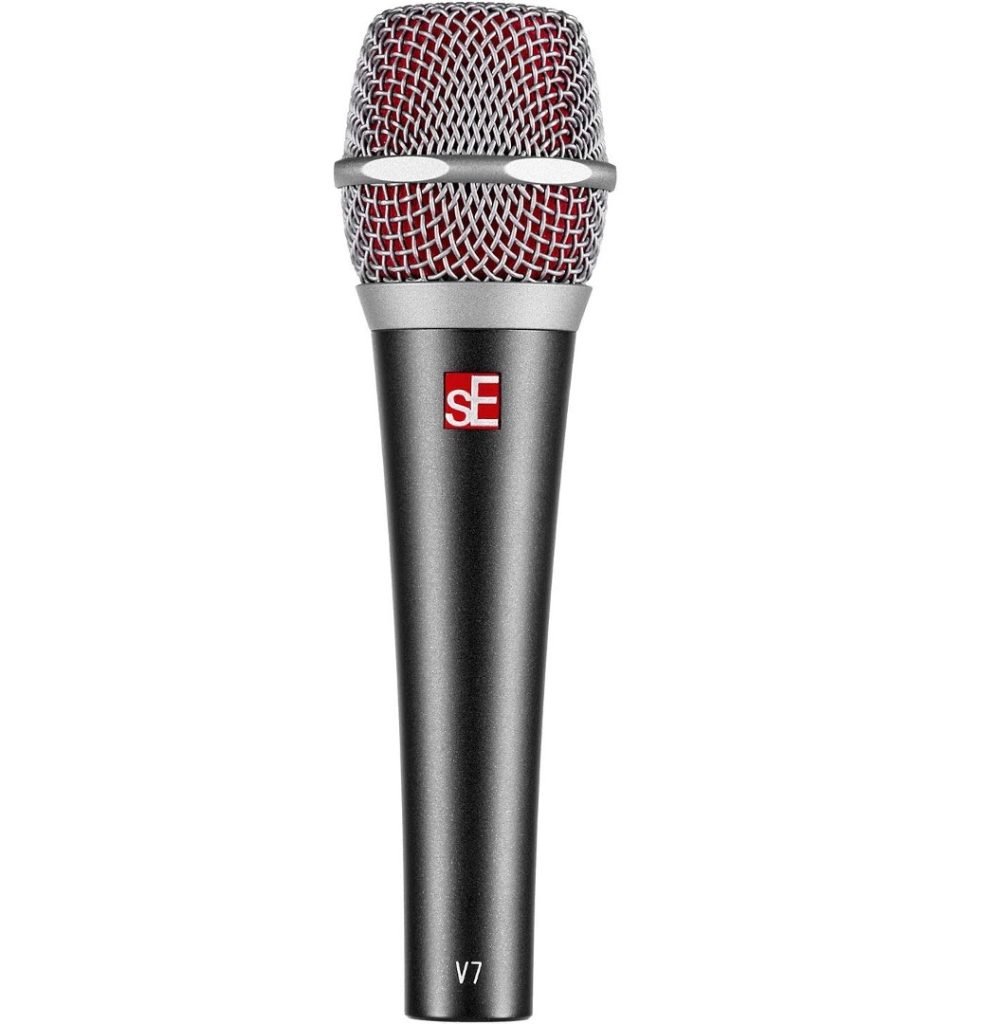
Another industry favorite for its flat and transparent sound signature…
The SE Electronics V7 Dynamic Microphone is a handheld microphone designed with a supercardioid pattern and can capture clear, crisp vocals while minimizing background noise. The microphone has a frequency range of 40Hz to 19kHz, aided by a lightweight aluminum voice coil that extends the frequency response, making it well-suited for both vocal and instrument recording at home.
When it comes to sound performance, the SE V7 microphone has a smooth response through the upper mids with little to no presence peak and provides a neutral and natural sound. I really like how the SE V7 captures clean and detailed vocals which sound much more robust than the Shure SM58 mics due to its wider frequency range.
The microphone also has low self-noise of 2 mV/Pa (-54dB), which makes it great for capturing louder vocals or drums. The microphone’s supercardioid polar pattern effectively minimizes background noise and this makes the V7 particularly good for home recording studios where there are background sounds and noises as they won’t be picked up by the microphone.
Compared to the Shure SM58 mics, both microphones have roughly the same size and weight but the SE V7 has the added advantage of an extended frequency range. The SE V7 mic provides a more airy character to higher end frequency ranges, which is ideally suited for those looking for a more open and transparent sound signature. The V7 also provides a comparatively strong resistance to feedback and is designed to reduce sound bleed which minimizes background sound pickup.
Overall, we liked the SE Electronics V7’s supercardioid pattern and good frequency range and low self-noise, which makes it ideal for home recording studios due to its minimal pickup.
6. RØDE PodMic USB Dynamic Microphone

The industry leading microphone for broadcasting speech…
The RØDE PodMic USB Versatile Dynamic Broadcast Microphone is a broadcast-quality dynamic microphone that offers both XLR and USB connectivity for professional recording. The microphone is optimized for podcasting, streaming, gaming and music making. The PodMic USB features a frequency response of 20Hz to 20kHz, an internal pop filter, and a swing mount for easy positioning. The microphone also has a zero-latency headphone output complete with level control which makes it easy to adjust during recording sessions.
I really like the level of detail that the RODE PodMic provides for vocals and songs. They can capture your vocals with great detail and have a generally neutral frequency response, which provides clear vocals without any coloration on your DAW. It can also capture subtle nuances in the vocals such as breathing and subtle pauses while singing.
The RØDE PodMic USB is essentially the same as the RØDE PodMic, but with the added convenience of USB connectivity. The PodMic USB is easy to drive with the USB connection and provides excellent output levels. The microphone also has a built-in Revolution preamp circuitry for tons of gain without distracting noise, and the APHEX DSP helps you deliver a polished, broadcast-quality sound. The microphone itself has a High-Pass Filter (HPF) locked to 60Hz, and comes with a cup-shaped pop filter to help reduce plosives
When the PodMic USB was tested against the Shure MV7 and SM58, it required less gain than the Shure MV7 but more than the SM58 to achieve a strong signal. We found that an external preamp like the SS-1 might be necessary to attain a stronger signal and to avoid additional noise from the interface.
Overall, the RØDE PodMic USB is a great choice for home recording studios because of its versatility and uncolored sound signature. The microphone is also fully compatible with the complete RODE software suite, including RODE Central, RODE Connect, RODE Capture, and UNIFY, making it easy to record broadcast-quality audio.
7. FIFINE XLR Dynamic Microphone
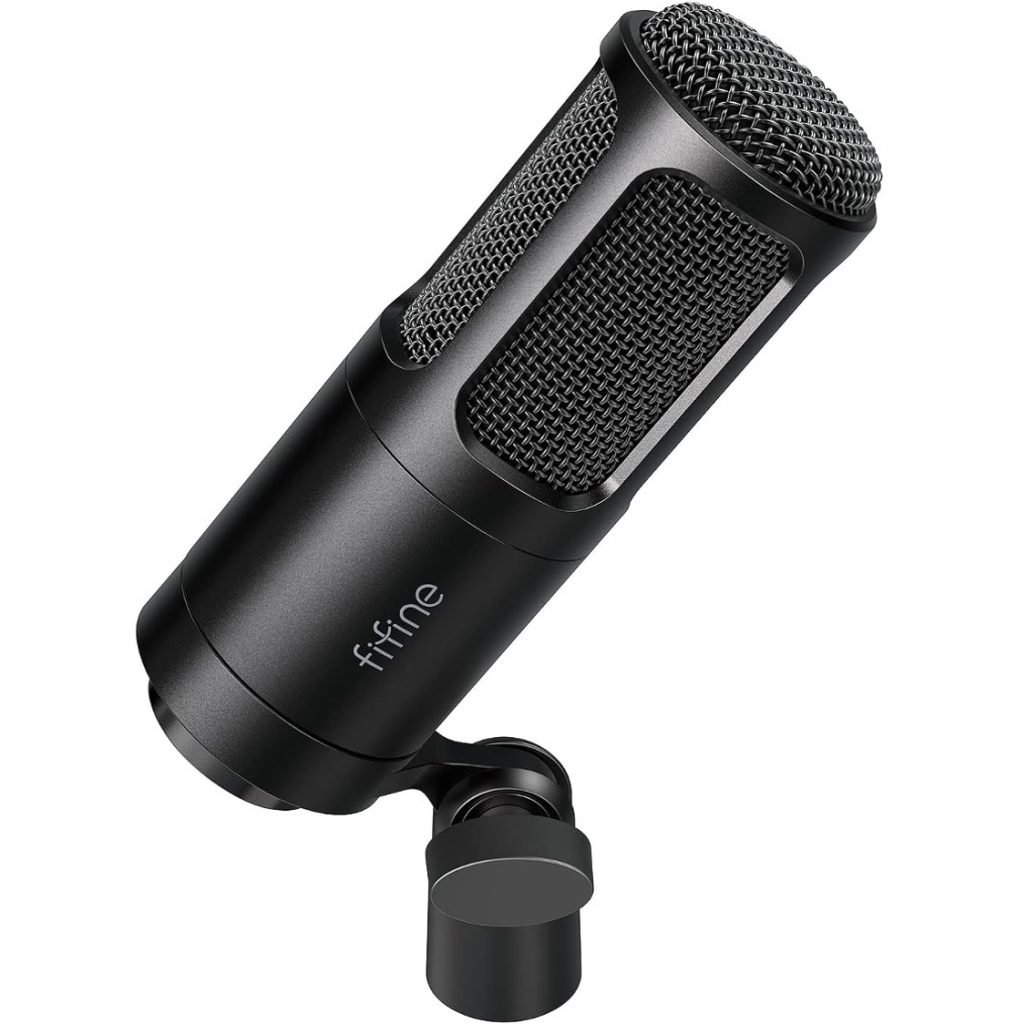
A versatile dynamic mic with both XLR and USB connections…
The FIFINE K688 is a dynamic microphone tailored for podcasting and recording vocals and is also widely used in the industry and home recording studios. It features both XLR and USB connections, making it versatile for different recording setups. The microphone comes in a sleek black-red rectangular box and is dubbed the “Amplitank” due to its dynamic nature specialized for podcasting.
When it comes to sound performance, the K688 is designed with Dynamic Hybrid Technology, which amalgamates the benefits of both dynamic and condenser microphones, offering a high-quality sound capture – in other words, it should sound somewhere in between a dynamic and condenser mic. Having said that, I found that this microphone may sometimes sound hollow while recording instruments, which might require some equalization in post-processing to achieve the desired sound profile.
When compared to other dynamics, the Shure SM7B tends to have a fuller sound compared to the FIFINE K688, however the Shure SM7B requires more gain and phantom power to drive it. When we tested the FIFINE K688 via XLR, we felt that it delivers a much fuller sound and deeper bass compared to its USB recording. The FIFINE K688 is pretty good at capturing male vocals and capturing lower frequency vocal tones.
Overall, we highly recommend the FIFINE K688 microphone for home recording studios due to its ease of use, minimal setup requirements, and the dual connectivity options (XLR & USB) that it offers. It’s essentially a plug-and-play device requiring minimal technical knowledge, making it accessible for beginners. The built-in features like tap-to-mute, gain control, real-time monitoring via a 3.5mm jack, and volume adjustments make it both an economical and user-friendly option for beginners.
8. Behringer SL 84C Dynamic Cardioid Microphone

Another good dynamic mic for those on a budget…
The Behringer SL 84C Dynamic Cardioid Microphone is tailored for capturing vocal performances with transparent sound reproduction and has a wide frequency range of 50Hz-15kHz. This microphone has a high signal output which captures subtle nuances and details in your voice. It features an integrated spherical wind and pop noise filter to mitigate plosive sounds and unwanted ambient noise.
Additionally, the microphone is equipped with a shock mount system to cut down handling noise and a 3-pin XLR connector to provide consistent signal integrity for proper signal flow in your home recording studio setup.
When compared to other dynamic microphones, the Behringer SL 84C is particularly good at rendering the mid-frequency vocal range with clarity. I really like the SL 84C’s brightened midrange performance which makes it good for capturing details in your vocal recordings.
Stacked against other microphones like the Behringer XM850 and the Shure SM7B, the Behringer SL 84C sounds incredibly clean with minimal distortion with a slight lift in the critical mid-range for capturing vocal nuances. This microphone has an ultra-wide frequency response which accurately captures nuances (especially in female vocals), making it a versatile choice for any home recording setup.
For home recording studios, the Behringer SL 84C is a great choice for musicians on a budget. It has a dynamic sound output, cardioid polar pattern, and a built-in noise reduction feature which are ideal for recording at home where it can filter out unwanted background noises.
9. PreSonus Revelator Dynamic USB Microphone
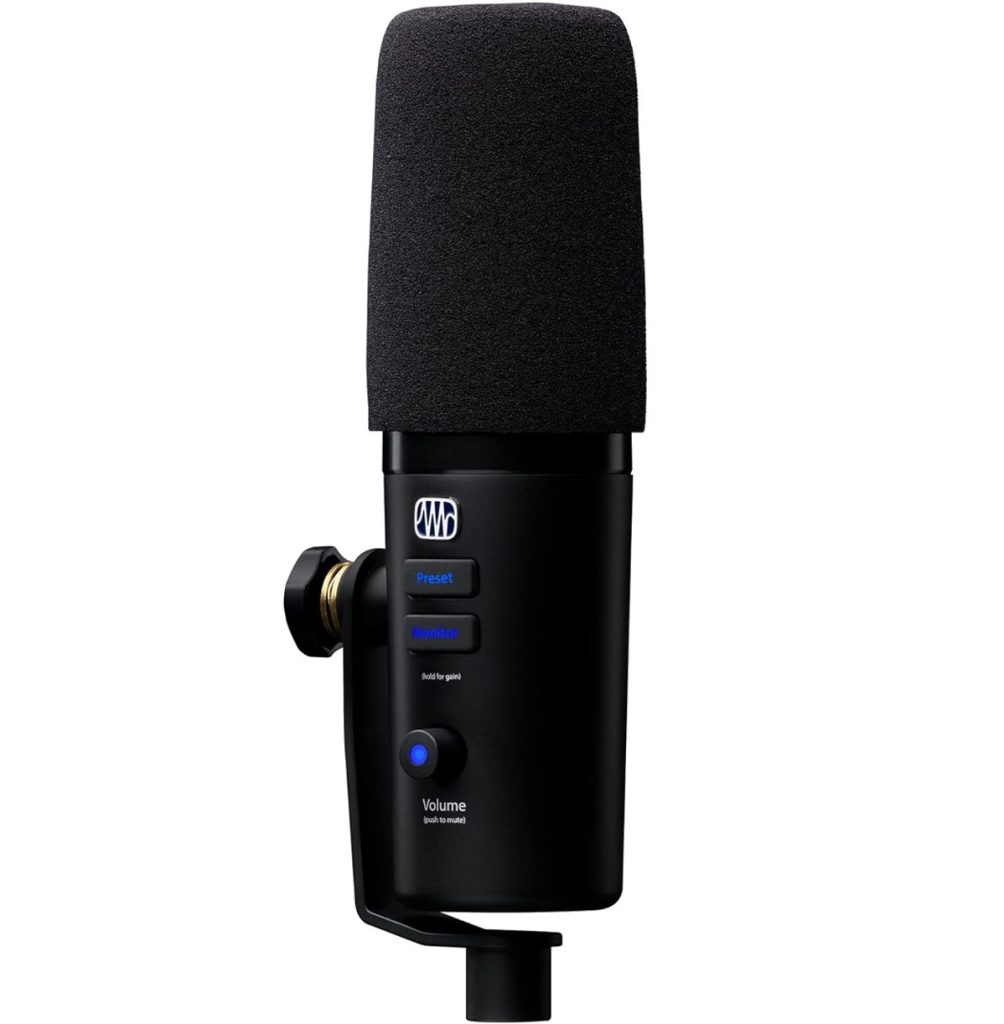
A very good dynamic mic for recording vocals and instruments…
The PreSonus Revelator Dynamic USB Microphone is a very good dynamic microphone which inherits the clarity and warmth from PreSonus’ PD-70 microphone (previous generation), with an added advantage of customizable presets to further refine the vocal output. This microphone has a frequency response of 20Hz to 20kHz and supports up to 24-bit/96kHz recording, and comes with an onboard 6-in/6-out USB interface for high-resolution audio.
In comparison to other dynamic microphones, the Revelator Dynamic excels in off-axis noise rejection, providing a cleaner audio output in noisy recording environments. This makes the PreSonus mic good for capturing vocals in a home recording studio setting where it won’t pick up surround sounds and noises.
When placed against competitors like the AKG Lyra or the Rode Podcaster, the Revelator Dynamic Microphone sounds almost as good with really nice balance in vocal tonality and sound pickup. To some extent I found this mic to have a similar sound profile to the Shure MV7 with a clean neutral dynamic range. Its dynamic capsule is optimized for close working, making it well-suited for vocal recording while being capable of handling high Sound Pressure Levels (SPLs) for instrument recording.
The PreSonus Revelator Dynamic USB Microphone excels in terms of its professional sound processing features including an integral loopback function, high-pass filter, gate, compressor, EQ, limiter, and voice modifier, all of which can be controlled via the PreSonus Universal Control software.
We also liked the inclusion of Studio One Artist DAW recording software and Studio Magic software bundle which is great if you don’t want to buy your own DAW software.
10. Shure PGA58 Dynamic Microphone

If you are looking for a “neutral” sounding microphone for vocals…
The Shure PGA58 Dynamic Microphone has a frequency response range of 50Hz to 16kHz and is tuned to capture the nuances in your vocals and has a very neutral and flat frequency response. I found this microphone great for capturing the subtle nuances in your vocals as they have a really flat response and adds no coloration to the vocals – they capture your vocals as it is in the recording studio.
Compared with other dynamic mics on this list, the PGA58 provides a more natural, uncolored sound and will really bring out the details in your vocals (as well as highlight the flaws). When compared to the Shure SM58, the PGA58 exhibits a flatter response, which helps in ensuring the vocals don’t get muddied by excessive low-frequency sounds.
The microphone does begin to roll off frequencies starting around 500Hz, with a notable boost peaking around 5.5kHz, adding a touch of presence to the vocal recordings. This microphone, however, may lack tonal body when recording instruments – I tested out the microphone together with electric and acoustic guitars and the mic provides a somewhat muddy sound on the electric guitar and lacked low-end warmth on the acoustic guitar. They aren’t designed to capture low-end frequency ranges.
Like most dynamic mics, the Shure PGA58 features a cardioid polar pattern to minimize background noise pickup. This mic has a black metallic finish and grille and is a very durable microphone which can be used not just for home recording but also live performances. The microphone is available in three options concerning cable connectivity, and includes an on/off switch for discrete control over its operation.
Overall, the Shure PGA58 Dynamic Microphone is a really good dynamic microphone that provides solid vocal reproduction and effective noise rejection. What I liked about the Shure PGA58 microphone is how well they capture vocals with a neutral and flat frequency response, allowing you to effectively “study” your vocals in the DAW because of its clean and natural sound pickup. It has a similar sound profile to the Shure SM58 but sounds flatter, and is one of the most neutral sounding dynamics you can get.
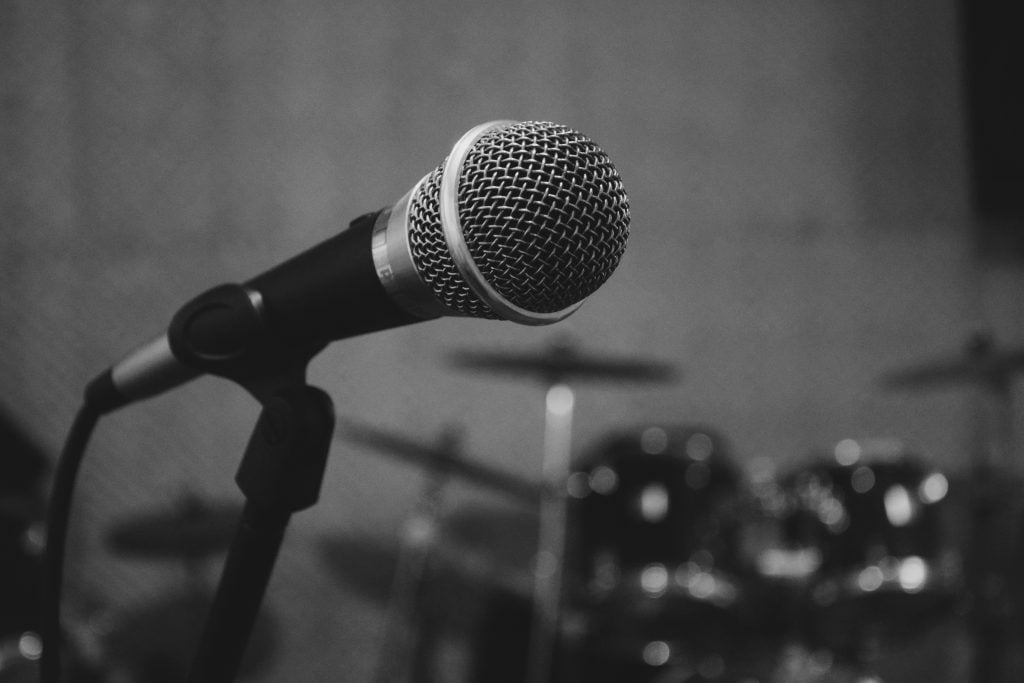
Frequently Asked Questions
Q: What is the polar pattern of a dynamic microphone?
A: Dynamic microphones typically have a cardioid polar pattern, which means they are most sensitive to sound coming from the front and reject sound from the sides and rear. This polar pattern helps to minimize feedback and isolate the sound source, making them ideal for live performances and recording vocals.
Q: Can I use a dynamic microphone for recording studio vocals?
A: Yes, dynamic microphones can be used for recording studio vocals. Many professionals prefer using condenser microphones for studio vocals due to their higher sensitivity and capture of more detail. However, dynamic microphones like the Shure SM7B and Electro-Voice RE20 are popular options for recording vocals because of their warm and dynamic sound characteristics.
Q: Should I choose a dynamic microphone with XLR or USB connectivity?
A: The choice between XLR and USB connectivity depends on your specific needs. XLR is the standard professional audio connection and is commonly used in studio and live sound applications. If you have an audio interface or mixer with XLR inputs, choosing a dynamic microphone with XLR connectivity would be ideal. However, if you are looking for a more portable and plug-and-play solution, USB dynamic microphones offer convenience and direct connection to a computer or mobile device.
Q: How do I position a dynamic microphone for the best sound?
A: Proper microphone positioning is essential for capturing the best sound. For vocals, position the dynamic microphone about 4-6 inches away from the singer’s mouth at a slight angle, pointing towards the corner of their mouth. For instruments, experiment with different placements to find the sweet spot that captures the desired sound. It’s also important to consider the polar pattern of the microphone and adjust the placement accordingly to minimize unwanted sound sources.
